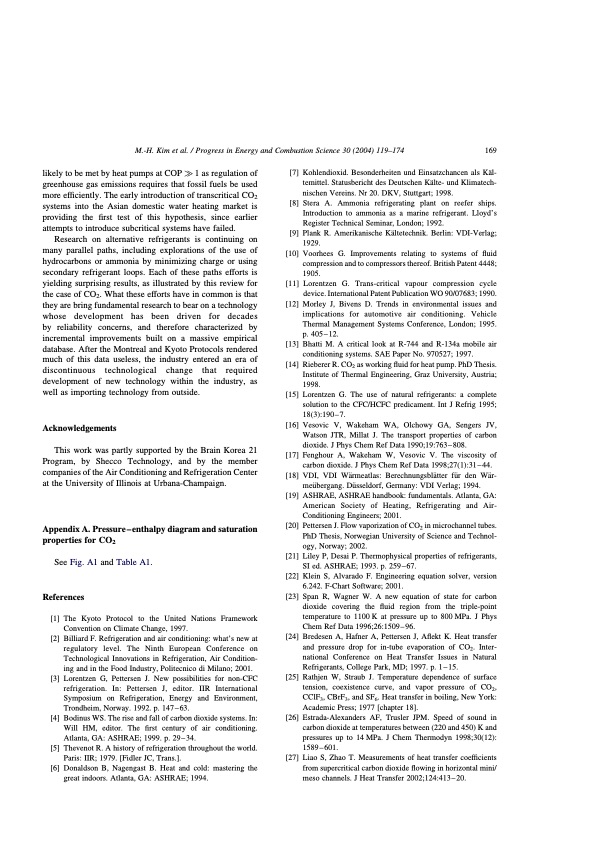
PDF Publication Title:
Text from PDF Page: 051
M.-H. Kim et al. / Progress in Energy and Combustion Science 30 (2004) 119–174 169 likely to be met by heat pumps at COP q 1 as regulation of greenhouse gas emissions requires that fossil fuels be used more efficiently. The early introduction of transcritical CO2 systems into the Asian domestic water heating market is providing the first test of this hypothesis, since earlier attempts to introduce subcritical systems have failed. Research on alternative refrigerants is continuing on many parallel paths, including explorations of the use of hydrocarbons or ammonia by minimizing charge or using secondary refrigerant loops. Each of these paths efforts is yielding surprising results, as illustrated by this review for the case of CO2. What these efforts have in common is that they are bring fundamental research to bear on a technology whose development has been driven for decades by reliability concerns, and therefore characterized by incremental improvements built on a massive empirical database. After the Montreal and Kyoto Protocols rendered much of this data useless, the industry entered an era of discontinuous technological change that required development of new technology within the industry, as well as importing technology from outside. Acknowledgements This work was partly supported by the Brain Korea 21 Program, by Shecco Technology, and by the member companies of the Air Conditioning and Refrigeration Center at the University of Illinois at Urbana-Champaign. Appendix A. Pressure–enthalpy diagram and saturation properties for CO2 See Fig. A1 and Table A1. References [1] The Kyoto Protocol to the United Nations Framework Convention on Climate Change, 1997. [2] Billiard F. Refrigeration and air conditioning: what’s new at regulatory level. The Ninth European Conference on Technological Innovations in Refrigeration, Air Condition- ing and in the Food Industry, Politecnico di Milano; 2001. [3] Lorentzen G, Pettersen J. New possibilities for non-CFC refrigeration. In: Pettersen J, editor. IIR International Symposium on Refrigeration, Energy and Environment, Trondheim, Norway. 1992. p. 147 – 63. [4] Bodinus WS. The rise and fall of carbon dioxide systems. In: Will HM, editor. The first century of air conditioning. Atlanta, GA: ASHRAE; 1999. p. 29 – 34. [5] Thevenot R. A history of refrigeration throughout the world. Paris: IIR; 1979. [Fidler JC, Trans.]. [6] Donaldson B, Nagengast B. Heat and cold: mastering the great indoors. Atlanta, GA: ASHRAE; 1994. [7] Kohlendioxid. Besonderheiten und Einsatzchancen als Ka ̈ l- temittel. Statusbericht des Deutschen Ka ̈lte- und Klimatech- nischen Vereins. Nr 20. DKV, Stuttgart; 1998. [8] Stera A. Ammonia refrigerating plant on reefer ships. Introduction to ammonia as a marine refrigerant. Lloyd’s Register Technical Seminar, London; 1992. [9] Plank R. Amerikanische Ka ̈ltetechnik. Berlin: VDI-Verlag; 1929. [10] Voorhees G. Improvements relating to systems of fluid compression and to compressors thereof. British Patent 4448; 1905. [11] Lorentzen G. Trans-critical vapour compression cycle device. International Patent Publication WO 90/07683; 1990. [12] Morley J, Bivens D. Trends in environmental issues and implications for automotive air conditioning. Vehicle Thermal Management Systems Conference, London; 1995. p. 405–12. [13] Bhatti M. A critical look at R-744 and R-134a mobile air conditioning systems. SAE Paper No. 970527; 1997. [14] Rieberer R. CO2 as working fluid for heat pump. PhD Thesis. Institute of Thermal Engineering, Graz University, Austria; 1998. [15] Lorentzen G. The use of natural refrigerants: a complete solution to the CFC/HCFC predicament. Int J Refrig 1995; 18(3):190 – 7. [16] Vesovic V, Wakeham WA, Olchowy GA, Sengers JV, Watson JTR, Millat J. The transport properties of carbon dioxide. J Phys Chem Ref Data 1990;19:763–808. [17] Fenghour A, Wakeham W, Vesovic V. The viscosity of carbon dioxide. J Phys Chem Ref Data 1998;27(1):31–44. [18] VDI, VDI Wa ̈rmeatlas: Berechnungsbla ̈tter fu ̈r den Wa ̈r- meu ̈bergang. Du ̈sseldorf, Germany: VDI Verlag; 1994. [19] ASHRAE, ASHRAE handbook: fundamentals. Atlanta, GA: American Society of Heating, Refrigerating and Air- Conditioning Engineers; 2001. [20] Pettersen J. Flow vaporization of CO2 in microchannel tubes. PhD Thesis, Norwegian University of Science and Technol- ogy, Norway; 2002. [21] Liley P, Desai P. Thermophysical properties of refrigerants, SI ed. ASHRAE; 1993. p. 259–67. [22] Klein S, Alvarado F. Engineering equation solver, version 6.242. F-Chart Software; 2001. [23] Span R, Wagner W. A new equation of state for carbon dioxide covering the fluid region from the triple-point temperature to 1100 K at pressure up to 800 MPa. J Phys Chem Ref Data 1996;26:1509–96. [24] Bredesen A, Hafner A, Pettersen J, Aflekt K. Heat transfer and pressure drop for in-tube evaporation of CO2. Inter- national Conference on Heat Transfer Issues in Natural Refrigerants, College Park, MD; 1997. p. 1–15. [25] Rathjen W, Straub J. Temperature dependence of surface tension, coexistence curve, and vapor pressure of CO2, CClF3, CBrF3, and SF6. Heat transfer in boiling, New York: Academic Press; 1977 [chapter 18]. [26] Estrada-Alexanders AF, Trusler JPM. Speed of sound in carbon dioxide at temperatures between (220 and 450) K and pressures up to 14 MPa. J Chem Thermodyn 1998;30(12): 1589 – 601. [27] Liao S, Zhao T. Measurements of heat transfer coefficients from supercritical carbon dioxide flowing in horizontal mini/ meso channels. J Heat Transfer 2002;124:413 – 20.PDF Image | CO2 Vapor Compression Systems

PDF Search Title:
CO2 Vapor Compression SystemsOriginal File Name Searched:
co2-vapor-compression-systems.pdfDIY PDF Search: Google It | Yahoo | Bing
CO2 Organic Rankine Cycle Experimenter Platform The supercritical CO2 phase change system is both a heat pump and organic rankine cycle which can be used for those purposes and as a supercritical extractor for advanced subcritical and supercritical extraction technology. Uses include producing nanoparticles, precious metal CO2 extraction, lithium battery recycling, and other applications... More Info
Heat Pumps CO2 ORC Heat Pump System Platform More Info
| CONTACT TEL: 608-238-6001 Email: greg@infinityturbine.com | RSS | AMP |